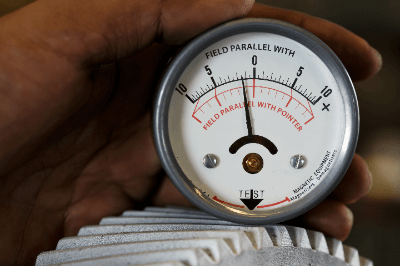What Is a Gaussmeter?

A Gaussmeter is a measuring instrument used to determine magnetic force.
Magnetic force, one of the electrical forces, is generated when electrically charged particles are set in motion, thus forming an electric current. Specifically, it is the force that attracts or repels magnets when they are close to each other. Generally, magnetic force is defined by magnetic flux density, which indicates the amount of magnetic flux per unit area at a given location.
When using a Gaussmeter, the appropriate shape and size are selected from a flat plate probe and a cylindrical probe, depending on the desired location and the type of object to be measured. The Tesla meter is a measuring instrument that uses the same principle as the Gaussmeter to measure magnetic force.
Usage of Gaussmeter
Gauss meters are generally used for the following applications:
- Measurement of environmental magnetic force.
- Measurement of magnetic force of permanent magnets and N/S pole discrimination.
- Measurement of geomagnetism in the natural world.
- Characteristic testing of magnetic materials.
- Scientific research related to magnetic materials and magnetic force.
Gaussmeter requires an appropriate choice of probe depending on the measurement environment. There are two main types of measurement probes: flat plate type and cylindrical type. Flat-plate probes are suitable for measurements in narrow gaps and linear magnetic fields, while cylindrical probes are suitable for measuring the magnetic force of small coils.
Principle of Gaussmeter
Gaussmeters utilize the Hall effect. The Hall effect is a phenomenon in which, when a magnetic field is applied to a semiconductor and a current flows in a direction perpendicular to the field, a voltage is generated that is proportional to the magnitude of the magnetic field and perpendicular to the current. Substances in which the Hall effect can be observed are called Hall elements.
A Gaussmeter measures the magnetic force from the magnitude of the voltage observed when a certain amount of current is applied to a probe made of a Hall element and the probe is placed at the point to be measured.
Types of Gaussmeters
There are two types of Gaussmeter: a small, lightweight portable type and a relatively large stationary type. Portable gaussmeters can be used anywhere. However, they are not suitable for high-precision measurements. The stationary type, on the other hand, limits the measurement location to some extent, but can measure magnetic forces over a wide range with high accuracy.
The appropriate model should be selected and used according to the measurement location, sample shape, and measurement environment, as well as the shape of the probe.
Other Information on Gaussmeter
1. Examples of Gaussmeter Usage
An example of a Gaussmeter in common use is a mini four-wheel drive toy. Mini 4WD is a motor-driven toy. There are competitions where the speed of the motor is the key to victory. Gaussmeter is used to select the motors.
Inside the motor is a coil, consisting of wire wound around itself. Generally, the more wires wound around a coil, the more power the motor can generate and the faster it can spin. Furthermore, the more neatly wound the coil is, the stronger the magnetic force it will emit. In other words, by measuring the magnetic force emitted from the motor with a Gaussmeter, it is possible to determine whether the wire is wound more or less neatly.
2. Smartphone Application for Gaussmeter
Some Gaussmeters are available as smartphone applications. Most smartphones these days come standard with an app that measures the direction you are facing (azimuth magnet app), which uses an internal magnetic sensor to calculate the azimuth.
The measuring principle of the smartphone application version of Gaussmeter is to use this magnetic sensor to detect the surrounding magnetism and measure the magnetic force. Since it is not a magnetic force measurement using a dedicated coil like the Gaussmeter of measuring instruments, it is not suitable for correct magnetic force measurement.
Furthermore, smartphones themselves emit electromagnetic waves, which can interfere with the magnetic force sensor. This interference is another reason why smartphone applications are not suitable for accurate magnetic force measurement. If you want to measure magnetic force accurately, it is important to use a commercially available Gaussmeter.